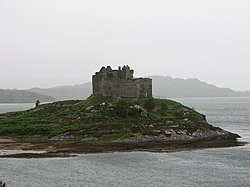Castle Tioram
| Castle Tioram | |

| |
|---|---|
| Location | |
| Location: | 56°46’48"N, 5°48’-0"W |
| Grid reference: | NM662724 |
| Highest point: | 30 ft |
| Data | |
| Population: | 0 |
Castle Tioram is a ruined castle that sits on the tidal island Eilean Tioram in Loch Moidart, Inverness-shire. It is located west of Acharacle, approximately 50 miles from Fort William. Though hidden from the sea, the castle controls access to Loch Shiel. It is also known to the locals as "Dorlin Castle". The castle is a scheduled monument.[1]
History
Built in the 13th century, the earliest reference to Tioram in the documentary record dates from 1373, when King Robert II confirmed an earlier charter, granted by John, Lord of the Isles, to his son Ranald. The island the fortress sits upon is first recorded in a charter of Cairistíona Nic Ruaidhrí (fl. 1290–1318), daughter of Ailéan mac Ruaidhrí (died ×1296).[2] According to early modern tradition, the castle was erected by Ailéan's granddaughter, Áine Nic Ruaidhrí (fl. 1318–50) in the 14th century.[3] The castle served as the seat of the latter's Clan Donald descendants for the next 400 years.[4]
Castle Tioram is the traditional seat of Clan MacDonald of Clan Ranald, a branch of Clan Donald. Castle Tioram was seized by Government forces in around 1692 when Clan Chief Allan of Clanranald joined the Jacobite Court in France, despite having sworn allegiance to the British Crown. A small garrison was stationed in the castle until the Jacobite Uprising of 1715 when Allan recaptured and torched it, purportedly to keep it out of the hands of Hanoverian forces. It has been unoccupied since that time, although there are some accounts suggesting it was partially inhabited thereafter including for the storage of firearms from the De Tuillay in the 1745 Jacobite Uprising and Lady Grange's account of her kidnapping.
Restoration proposals
The condition of the castle is disputed. Highland Council issued a Dangerous Buildings Order, closing the castle to the public, in 1998. A significant collapse, comprising several square yards of the outer layer of the north-west curtain wall, occurred in 2000, and was repaired by the owners. On the other hand, a condition report in September 2014 found that there has been no evident change in the stonework since then.
Proposals to restore the castle by the new owners, Anta Estates, were announced in 1997 and received planning consent. This included the creation of a clan centre/museum, domestic apartments, and some public access. However, Historic Scotland refused Scheduled Monument Consent; a decision upheld after a local public inquiry.[5]
The Royal Commission on the Ancient and Historical Monuments of Scotland, now part of Historic Environment Scotland, holds a substantial archive of research information, drawings, and photographs lodged by the current owners.
Eilean Tioram
The castle can be reached on foot across the tidal causeway, but there is no access to the interior because of the risk of falling masonry. Eilean Tioram is one of 43 tidal islands that can be walked to from the mainland of Great Britain.[6]
In popular culture
The castle provided a location for the film Highlander III: The Sorcerer (1994).
Notes
- ↑ "Castle Tioram & Eilean Tirim. SM955". Historic Environment Scotland. http://portal.historicenvironment.scot/designation/SM955. Retrieved 20 March 2017.
- ↑ Stell (2014) p. 273; Boardman, S (2006) p. 46; Fisher (2005) p. 91; Raven (2005) p. 63; McDonald (1997) pp. 189–190 n. 120.
- ↑ Stell (2014) pp. 273–274.
- ↑ Fisher (2005) p. 91.
- ↑ "Castle Tioram: Our statement on bringing Castle Tioram back into residential use". Historic Environment Scotland. https://www.historicenvironment.scot/about-us/news/castle-tioram/. Retrieved 20 March 2017.
- ↑ Caton, Peter (2011) No Boat Required - Exploring Tidal Islands. Matador.
References
- Boardman, S (2006). The Campbells, 1250–1513. Edinburgh: John Donald. ISBN 978-0-85976-631-9.
- Fisher, I (2005). "The Heirs of Somerled". in Oram, RD; Stell, GP. Lordship and Architecture in Medieval and Renaissance Scotland. Edinburgh: John Donald. pp. 85–95. ISBN 978 0 85976 628 9.
- McDonald, RA (1997). The Kingdom of the Isles: Scotland's Western Seaboard, c. 1100–c. 1336. Scottish Historical Monographs (series vol. 4). East Linton: Tuckwell Press. ISBN 978-1-898410-85-0.
- Raven, JA (2005). "Medieval Landscapes and Lordship in South Uist". University of Glasgow. http://theses.gla.ac.uk/1116/.
- Stell, G (2014). "Castle Tioram and the MacDonalds of Clanranald: A Western Seaboard Castle in Context". in Oram, RD. The Lordship of the Isles. The Northern World: North Europe and the Baltic c. 400–1700 AD. Peoples, Economics and Cultures (series vol. 68). Leiden: Brill. pp. 271–296. doi:10.1163/9789004280359_014. ISBN 978-90-04-28035-9.
- Tabraham, C (2005) [1997]. Scotland's Castles. London: BT Batsford. ISBN 0 7134 8943 X.
Outside links
| ("Wikimedia Commons" has material about Castle Tioram) |